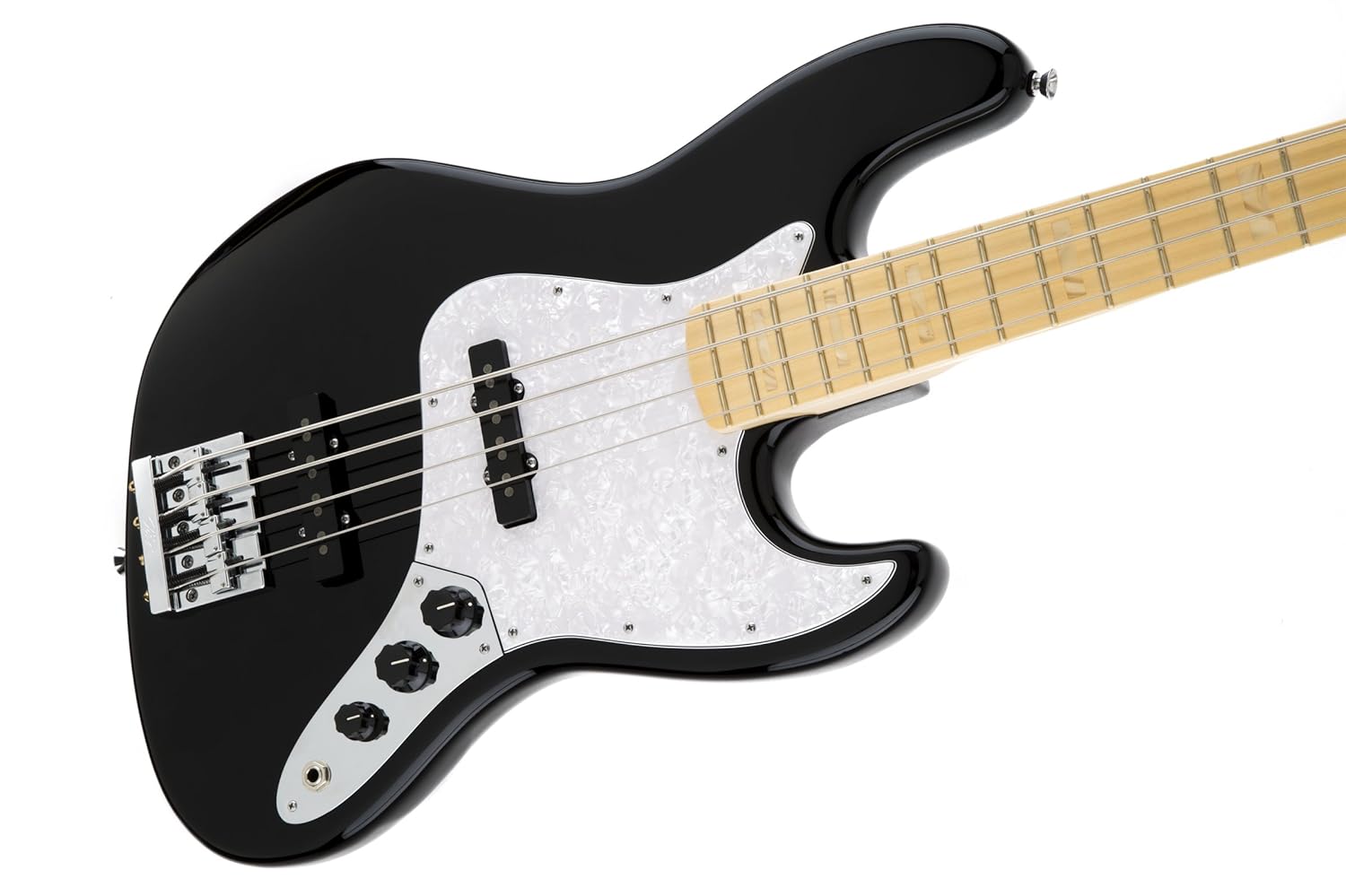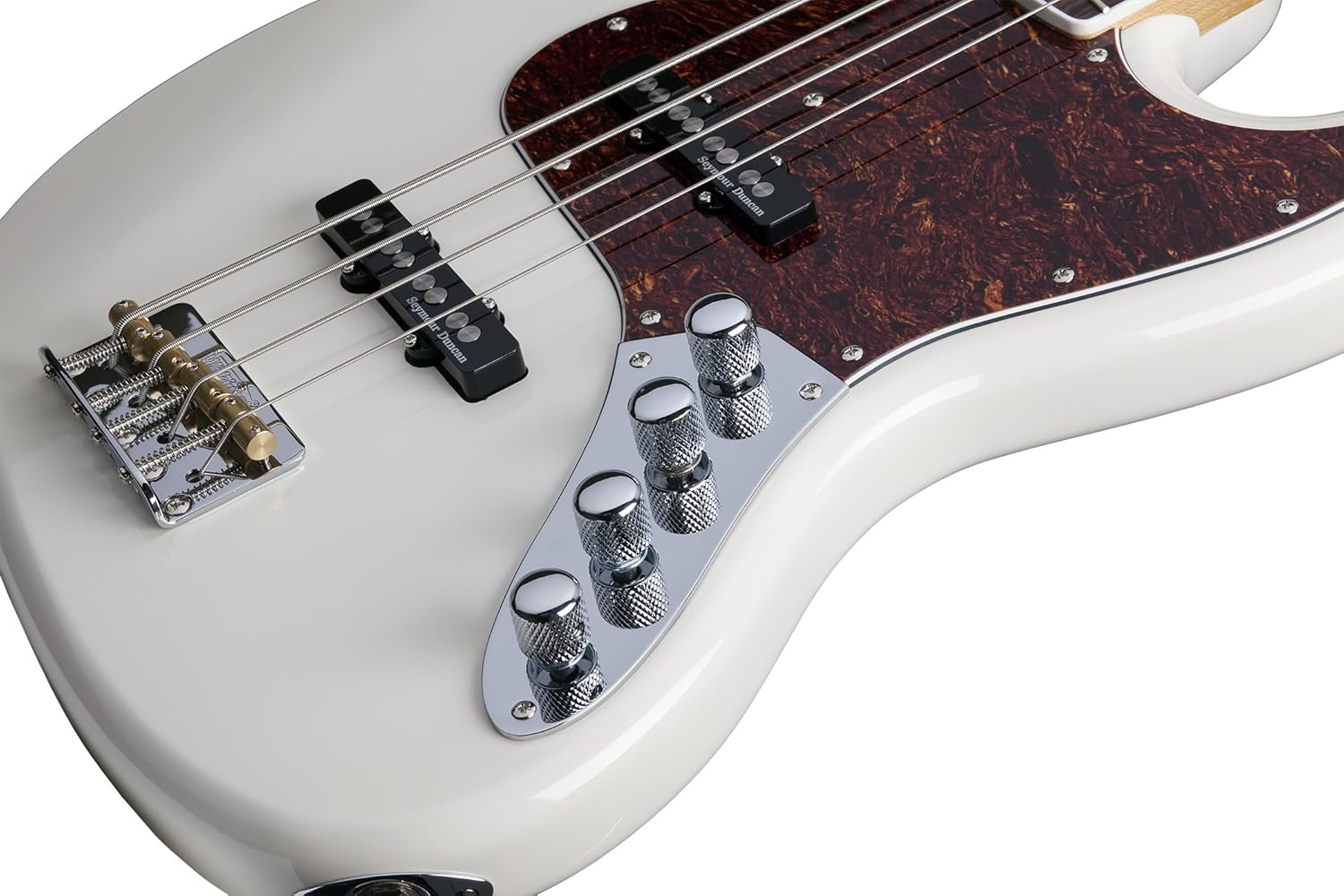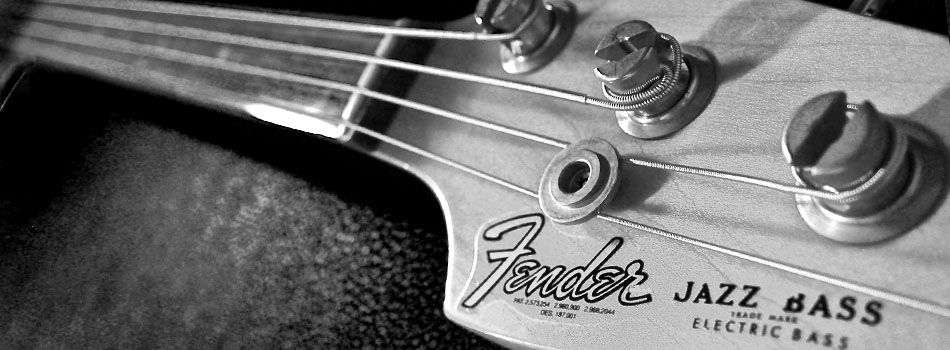Best Jazz Bass Guitar in 2019
Introduction: A Foreword about the Best Jazz Bass Guitar
Despite the fact that players can choose from hundreds of different bass guitar models, certain traditional designs have stood the test of time fairly well and stayed popular among players of all genres.
One such design is the Jazz Bass. Today, we’re going to introduce you to the world of J-Bass models and show you our 4 picks for the Best Jazz Bass Guitars.
The Jazz bass was introduced by Fender in the 1960s and their description of the J-Model goes as follows “Slightly narrow at the nut, the slim Jazz Bass neck is designed for speed, comfort and performance”.
The Jazz Bass has a less symmetrical and more contoured body shape than the Fender’s Precision models.
The ability to blend the volume of two pickups allowed for a wider variety of tones than what the Precision Bass and other single pickup basses of the 1960s could produce.
Usually, the pickups are RWRP (reverse wound, reverse polarity) from one another, so all hum will be canceled when both pickups are at full volume.
Besides Fender, other companies have tried to produce similar basses. Some models have a significantly different body and neck shapes, but the two-pickups design has become a standard for many bass companies.
Others are less subtle in their effort to emulate the classical Jazz Bass design. This is true for both mass-produced basses and for custom shop companies.
QUICK RUNDOWN

- Sonically slice through the mix
- Custom shaped to Geddy's spec Jazz neck

- Dual Lakland USA Vintage Single Coil Pickups
- Graphite Reinforcement bars

- Wilkinson WBBC Custom Bridge
- Seymour Duncan SJ5-3 Quarter Pound Pickup

- 4 Saddle HiMass bridge
- A modern 'C' shaped maple neck
Table of Contents

Due to the high number of Fender Jazz Bass models and alternatives from other manufacturers, there are countless jazz bass guitar reviews available online. So how does our article differ?
We will try to give you four different options that will take into consideration your budget, your needs. We are also going to try to give you a comparison between Fender models and the alternatives offered by other companies.
Sadly, most instruments aren’t designed for every genre there is, but the beauty bass guitars is that you can usually own more than one of them and that certain parts are exchangeable.
We’re going to give you tips for potential upgrades that might fit your playing style better and that will turn your bass into a very unique instrument.
On the other hand, we will avoid basses that need a lot of work to be proper instruments – all the basses on our list will require only new strings and a proper neck setup to be playable.
Let’s start our countdown:
Best Jazz Bass GUITAR Under $2000
A quick overview:
Endorsed and co-designed by the Geddy Lee, a living legend among bassists, the Fender US Geddy Lee Jazz Bass Guitar is crafted only with the highest-quality material and flawless parts, all combined into a rock-bass of the highest caliber.
The bass is superb in every regard – the sound, the looks and the design are all up to par with any custom shop models which cost significantly more.
To top it off, a Hard-Shell Case is also included.
Tone and Sound:
The Geddy Lee USA Jazz Bass is a sonic replica of Rush’s classic bass sounds. The bass comes with incredible, custom-voiced Fender American Vintage ’70s Geddy Lee pickups.
The bass comes with decent Fender 7250M .045 -.105 strings that can be replaced with your favorite type of Rotosound strings. Geddy Lee usually used Rotosound RS66LD strings on his Fender basses, but he also used Rotosound FM66 Swing Bass strings on other guitars.
The massive hardware offers rock-solid sustain, intonation and tuning stability. The parallel custom pups offer plenty of punch and clarity along with genuine vintage Fender vibe.
All in all, the bass has a remarkably good tone for practicing, recording and rock concerts.
Feel and Playability:
The oiled neck is fast-playing and not sticky, while the fretboard offers a vintage ’70s feel with a 9.5 inch radius and larger frets. On the other hand, the neck is slightly chunkier than older Geddy Lee models or the American Standard basses.
The difference is not too big to discourage Jazz Bass players from trying this model and it might even be appealing to P-Bass players.
Fender has incorporated a great-feeling hand-rubbed oil finish on the US Geddy Lee Jazz Bass, which feels smooth and broken in on the Custom Thick “C” neck profile.
The binding on the neck covers the ends of the frets completely resulting in a buttery smooth playing experience. The maple fretboard adds to the same fluid experience. To put it short, this is a real shredder’s bass.
Design and Looks:
This bass is modeled Geddy Lee’s three favorite instruments. For live performances, the bass looks marvelous, especially when it catches the light.
The inlays bring a visual life to the neck, much like the pearloid pick guard does to the gloss-black body. Lee’s signature the back of the headstock commemorates the lasting legacy of one of rock ‘n’ roll’s most versatile and technical bassists.
- Tone and Sound 97%
- Feel and Playability 95%
- Design and Looks 92%
- Smooth and designed for fast licks
- Great parts and craftsmanship
- Affordable high-end, professional instrument
- Thicker neck differs from traditional J-Models
Best Jazz Bass GUITAR Under $1500
A quick overview:
The Lakland Skyline Series offers a flawless blend of traditional design and modern features. This is a true 21st century 5- string bass made for full-time musicians.
For those who prefer an even more classic approach, a four string version is also available.
Tone and Sound:
The 35-inch scale offers a better intonation for the low B string, which is more or less a standard for certain genres of music. This workhorse bass is amazing for theater and musical venues, for weddings and for jazz performances.
The extended range provides a lot of additional tonal possibilities, though a slight adjustment of technique is required if you’ve played only four string basses before.
The pickups are vintage-style and deliver a fairly old-school tone. Due to the combination of a low B and vintage pickups, we recommend using a decent compressor with this bass to even out the tone a little bit, but this is purely optional.
The pickups don’t cancel out the hum perfectly, but if its vintage sound you want, that’s what you’re getting.
Feel and Playability:
Many 5 string basses are built with a 35-inch scale to accommodate the low B. The Lakland fiver is one of such basses. If you are too used to the 34-inch scale or have smaller hands, this may very well be a problem for you. Players with bigger hands won’t mind that, though.
The narrow neck is great on this fiver and the bass is very comfortable for the left hand, not only because of the great binding. The body is very similar to a Fender J-bass, but not quite the same.
It is very comfortable and contoured, somewhat like a Jaguar bass. The Hipshot ultra light tuners don’t only offer amazing tuning stability, but make the bass fairly lightweight.
Design and Looks:
Darryl Jones (The Rolling Stones, Miles Davis, Sting, Stone Raiders) designed this bass with Lakland. You can be sure that they succeeded in their effort to create an unblemished bass for live performances.
The bass looks great on stage and the inlays are simply gorgeous! The dark tuners look fancy and exquisite.
As for the neck, it has Graphite Reinforcement bars, which will keep your bass perfectly intonated even during temperature changes and make sure that your bass lasts for years to come.
Finally, the Lakland Dual-Design bridge is sturdy and enables easy and fast string changing.
- Tone and Sound 92%
- Feel and Playability 90%
- Design and Looks 94%
- Narrow neck
- Great tuning stability
- Perfect live-giging axe
- Longer scale neck
Best Jazz Bass GUITAR Under $1000
For the heavy-metal and hard-rock player on a budget, Schecter is never a bad choice. But these basses don’t just pack a lot of punch – the Schecter Diamond-J Electrid Bass has a lot of tonal versatility and feels great for the price.
While not the most sophisticated model on the market, it is a good choice for people who want to get a quality Jazz Bass for their collection.
Tone and Sound:
The stock pups are the Schecter Diamond Monster Tone II pickups, which offer massive that is great for harder variations on rock, R’n’B and pop songs.
Where the bass shines are metal and punk genres. If you’re used to playing J-Style basses, but need a little bit more power, then the Schecter J won’t disappoint.
The bass has a push-pull knob which offers you to switch from modern, scooped sounds to a more vintage type of tone with a single, effortless movement.
Because of that, the bass has loads of tone in a standard, 3-knob package. As this bass is generally aimed towards dirty styles, a distortion pedal might come be useful to have.
The MXR M84 Bass Fuzz will let out the inner growl of this bass come out perfectly, although other pedals could work fine as well. In short, sound and tonal versatility are the primary advantages of this axe.
Feel and Playability:
The neck of this bass feels great, is smooth and lacquered. The body is comfortable, very similar to a traditional Jazz bass. It comes with different fretboard types that will appeal to different players equally well.
The medium frets feel great and the neck is fairly comfortable. Sadly, the neck has no neck-binding. While it would’ve been a nice addition, this is understandable at this price point.
All in all the bass feels quite nice, but not like the most spectacular bass ever.
Design and Looks:
The Diamond-J Electric Bass has quite a good build considering the very low price and is comparable to Fender Made In Mexico basses, while the price is more around the Squier Classic Vibe series.
A great feature is the really heavy, huge bridge that will provide a lot of sustain. The same goes for the amazing Grover Vintage tuners that will provide solid tuning stability and further improve the sustain of notes.
The bass doesn’t look quite as good as some higher end models. Especially the headstock has that low-end feel to it. But as long as you’re not too concerned about the visual aspect, you won’t be bothered.
The body and the neck have a really nice, traditional jazz bass feel to them, so it’s not a drastic change from a traditional Fender J-Style bass.
- Tone and Sound 89%
- Feel and Playability 82%
- Design and Looks 84%
- Amazing price
- High-Quality Hardware
- Push-Pull Switch
- Doesn’t feel or look sophisticated
Best Jazz Bass GUITAR Under $500
A quick overview:
Squier by Fender produces many great entry-level instruments, but the countless different series’ can be confusing. While the Squier Bullet, Squier Affinity and Squier Standard series’ should generally be avoided, the Squier Classic Vibe and the Squier Vintage Modified basses are amazing low-cost alternatives to a real Fender.
The Squier Deluxe Active Jazz bass, on the other hand, is a hidden gem even among Squier basses. This time, the active bass is our choice because of the nearly endless tonal possibilities packed in a very affordable package.
Tone and Sound:
While the Classic Vibe basses are incredible for their price, comparable even to real Fender basses, the Deluxe Active Jazz Bass takes away the spotlight with the active electronics. The bass has a lot of knobs: Master Volume, Blend, a stacked Treble/Bass knob, Middle, and also a Slap Switch.
While this might be confusing for new players (who should probably start with a simple P-Bass instead anyway), old-school players will have a lot of time to play around with the endless number of combinations of pickups and sounds.
There is not a lot of room for improvement on these basses. The only thing that you could do is change the pickups for a different brand, which might not increase the amount of tonal possibilities, but will definitely improve the quality of existing ones.
But if you want a quick way to give it even a little bit more edge, go with some high-quality bass strings brand like Elixir or DR. The Deluxe Active is also available as a 5 string, although for a slightly higher price.
The low B gives additional tonal possibilities and an extended range, but unlike models by other companies, it retains the 34 inch scale.
Feel and Playability:
There is not a lot to say about the feel and playability of this model. If you’ve ever tried a Jazz bass, you kinda know how this feels and plays.
The only important difference is the unique Ebonol fretboard. Ebony fretboards are kinda rare on electric basses, although they are standard for Upright basses and other bowed instruments.
The ebony fretboard doesn’t just look amazing in combination with the black body – it also feels very exquisite, sophisticated and somewhat as a middle-ground between maple and rosewood.
If you want a bass with an ebony fretboard or if you’re an upright bass player, you will probably appreciate and enjoy this amazing model.
Design and Looks:
The woods used and the pickups could definitely be of higher quality, but considering the incredibly low price, the Deluxe Jazz is a great model.
A pickguard would look great, but considering the all-black design this is not too much of an issue. The gloss polyurethan3 finish that extends over the headstock covers up the average-looking headstock.
The bass looks simply fabulous, although it would be better if the neck was oiled or had a nitro finish, too.
If you want to expand on the all-black design, consider using DR Black Beauties 40-100. These strings don’t just look great, but also play effortlessly as the round-core design and thin gauge can be pressed down with ease.
- Tone and Sound 88%
- Feel and Playability 77%
- Design and Looks 81%
- Endless Tonal Combinations
- Active Bass
- Astonishing Looks
- Low-End Woods and Hardware
THINGS TO CONSIDER:
The number of Fender and Squier Jazz basses is really high, especially considering that they’ve been produced since the 1960s. Furthermore, other companies have expanded and adopted the design as well.
Your choice will ultimately depend on 5 factors:
- Your preferred string count – as Jazz basses rarely go beyond 5 strings, you can either choose a 4 or 5 string version;
- Scale length – 35 inch, 34 inch or some short scale models like the Jaguar bass;
- Your fretboard preference – Ebony, Maple or Rosewood;
- Your soundboard and EQ preference – active or passive;
- Your budget.
If you’re unsure on what to buy, consider comparing the Jazz basses to other popular models and consider getting an affordable Classic Vibe, Vintage Modified or Deluxe series Squier bass before moving on to more expensive models.
These models can be upgraded with additional pickups, new tuning pegs, a new neck, or by simply using a pedal.
CONCLUSION
All in all, the choices are endless. The good thing is that you can keep more than one bass at home. Consider what you’re exactly looking for and keep in mind that no bass will cover absolutely all of your needs.
Playing different models and getting used to different string counts and scale lengths will make you more flexible and versatile as a musician. Also, experiment with different strings as strings can definitely change the feel of a bass.
Good luck and all the best!



